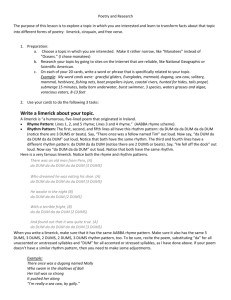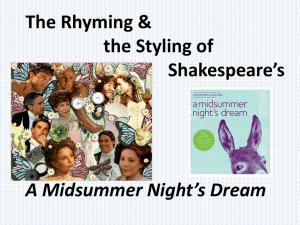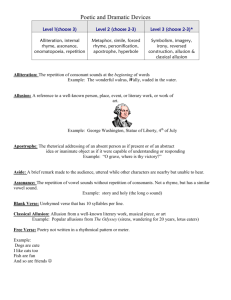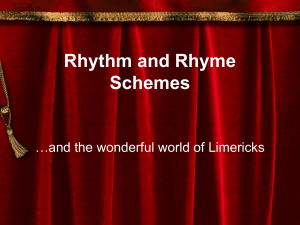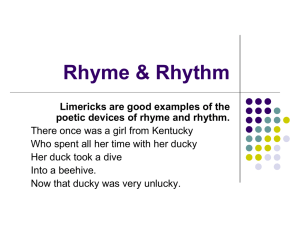Poetry Writing Ideas
advertisement
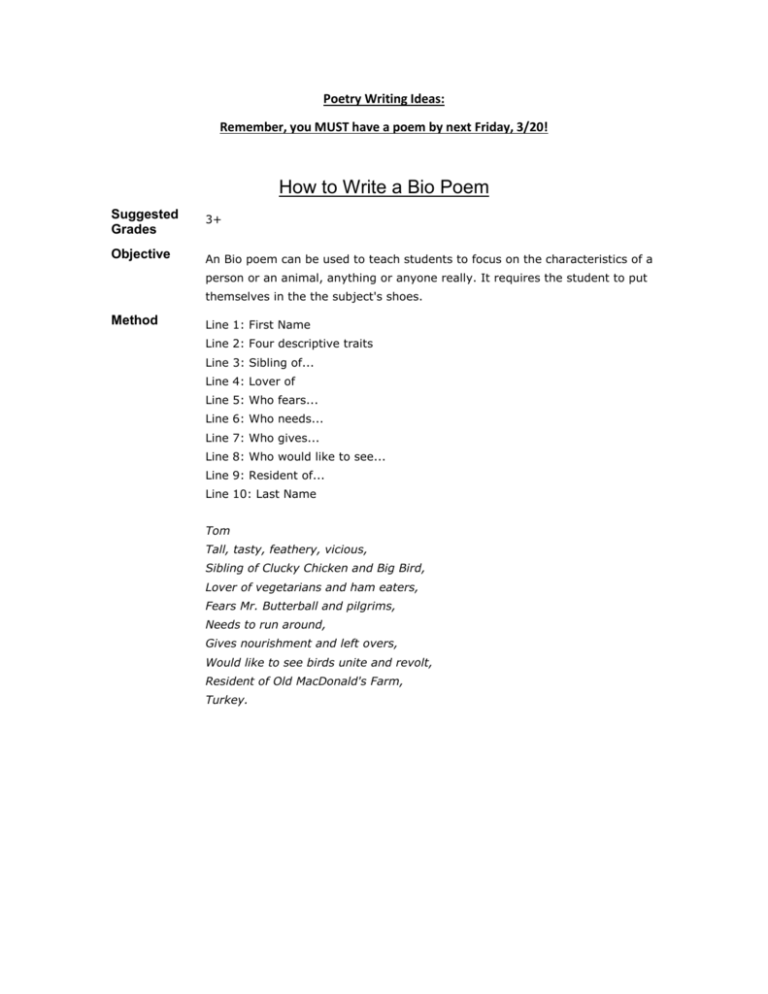
Poetry Writing Ideas: Remember, you MUST have a poem by next Friday, 3/20! How to Write a Bio Poem Suggested Grades 3+ Objective An Bio poem can be used to teach students to focus on the characteristics of a person or an animal, anything or anyone really. It requires the student to put themselves in the the subject's shoes. Method Line 1: First Name Line 2: Four descriptive traits Line 3: Sibling of... Line 4: Lover of Line 5: Who fears... Line 6: Who needs... Line 7: Who gives... Line 8: Who would like to see... Line 9: Resident of... Line 10: Last Name Tom Tall, tasty, feathery, vicious, Sibling of Clucky Chicken and Big Bird, Lover of vegetarians and ham eaters, Fears Mr. Butterball and pilgrims, Needs to run around, Gives nourishment and left overs, Would like to see birds unite and revolt, Resident of Old MacDonald's Farm, Turkey. How to Write a Cinquain Suggested Grades 1+ Objective At the most basic level a cinquin is a five line poem or stanza. Here are two variations. Method Line 1 - a one word title Line 2 - a 2 word phrase that describes your title or you can just use two words Line 3 - a 3 word phrase that describes an action relating to your title or just actions words Line 4 - a 4 word phrase that describes a feeling relating to your topic or just feeling words Line 5 - one word that refers back to your title Line Line Line Line Line 1 2 3 4 5 - two syllables four syllables six syllables eight syllables two syllables How to Write an I Am Poem Suggested Grades 3+ Objective An I Am poem is a good way to teach children to focus on their own characteristics. It also is a good ice breaker for the beginning of the year. Method I Am I am (two special characteristics) I wonder (something you are actually curious about) I hear (an imaginary sound) I see (an imaginary sight) I want (an actual desire) I am (the first line of the poem restated) I pretend (something you actually pretend to do) I feel (a feeling about something imaginary) I touch (an imaginary touch) I worry (something that really bothers you) I cry (something that makes you very sad) I am (the first line of the poem repeated) I understand (something you know is true) I say (something you believe in) I dream (something you actually dream about) I try (something you really make an effort about) I hope (something you actually hope for) I am (the first line of the poem repeated) Writing an Ode How to Write a Limerick by Bruce Lansky To help you get started writing limericks, here’s some helpful information about writing limericks. To begin, a limerick is a funny little poem containing five lines. It has a very distinctive rhythm and rhyme pattern. Rhyme Pattern: The last words of the first, second, and fifth lines all rhyme with each other. We’ll call those rhyming words “A,” however the words could be “ Peru,” “shoe,” and “true” as illustrated in the first poem below or “Tim,” “swim,” and “him” as illustrated in the second poem below. And the last words of the third and fourth lines rhyme with each other. We’ll call those rhyming words “B,” however the words could be “night” and “fright” in the first example or “dock” and “rock” in the second example. Rhythm Pattern: The first, second, and fifth lines all have this rhythm pattern: da DUM da da DUM da da DUM (notice there are 3 DUMS or beats). Say, “There once was a fellow named Tim” out loud. Now say, “da DUM da da DUM da da DUM” out loud. Notice that both have the same rhythm. The third and fourth lines have a different rhythm pattern: da DUM da da DUM (notice there are 2 DUMS or beats). Say, “He fell off the dock” out loud. Now say “da DUM da da DUM” out loud. Notice that both have the same rhythm. Here is a very famous limerick. Notice both the rhyme and rhythm patterns. There was an old man from Peru, (A) da DUM da da DUM da da DUM (3 DUMS) who dreamed he was eating his shoe. (A) da DUM da da DUM da da DUM (3 DUMS) 3. He awoke in the night (B) da DUM da da DUM (2 DUMS) with a terrible fright, (B) da da DUM da da DUM (2 DUMS) 5.and found out that it was quite true. (A) da DUM da da DUM da da DUM (3 DUMS) When you write a limerick, make sure that it has the same AABBA rhyme pattern. Make sure it also has the same 3 DUMS, 3 DUMS, 2 DUMS, 2 DUMS, 3 DUMS rhythm pattern, too. To be sure, recite the poem, substituting “da” for all unaccented or unstressed syllables and “DUM” for all accented or stressed syllables, as I have done above. If your poem doesn’t have a similar rhythm pattern, then you need to make some adjustments. Ideas for new limericks can come from almost anywhere. For example, your city, state, country, or name. If your name is Tim or Jim, you could write something like this: A Clumsy Young Fellow Named Tim 1. 2. 3. 4. 5. There once was a fellow named Tim (A) whose dad never taught him to swim. (A) He fell off a dock (B) and sunk like a rock. (B) And that was the end of him. (A) Notice that the rhyme pattern (AABBA) and the rhythm pattern (3 DUMS, 3 DUMS, 2 DUMS, 2 DUMS, 3 DUMS) are almost identical to the rhythm and rhyme patterns in the “Man from Peru” limerick. OK, now that you know what the rhythm and rhyme patterns of a limerick are, you’re ready to write one. Here are five simple steps to writing a limerick: 1. An easy way to get started is to pick a boy’s or girl’s name that has one syllable (like Bill, Tim, Dick, Sue, or Jill). There once was a fellow (or young girl) named ____(pick an easy name with one syllable). We’ll pick “Jill.” So the first line is: “There once was a young girl named Jill.” 2.Now make a list of words that rhyme with the last word in the first line—in this case, Jill. Your list of rhyming words might include: hill, drill, pill, skill, bill, will, and ill. 3. Now write the second line using one of the rhyming words. Here’s an example: “Who freaked at the sight of a drill.” (Notice that the last words in the first two lines rhyme and that both the first and second lines contain 3 DUMS or beats.)4. Now think of an interesting story. What could happen to someone scared of a drill? Well, you might have an interesting story if Jill had to go to the dentist. Here’s what might happen in the third and fourth lines. “She brushed every day.” “So, her dentist would say,” (Notice that “day” and “say,” the last words in the third and fourth lines, both rhyme. And notice there are 2 DUMS or beats in each line.) 5. Now you need to go back to the list of “A” rhyming words to find one that can end the poem. Here’s an example: “Your teeth are quite perfect. No bill.” Here’s the poem we just wrote: There once was a young girl named Jill. Who was scared by the sight of a drill. She brushed every day So her dentist would say, “Your teeth are so perfect; no bill.” Now try it yourself!

